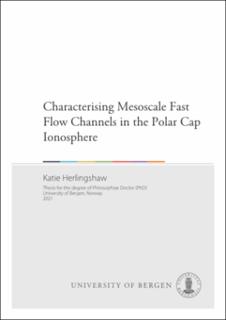Characterising Mesoscale Fast Flow Channels in the Polar Cap Ionosphere
Doctoral thesis
Permanent lenke
https://hdl.handle.net/11250/2724001Utgivelsesdato
2021-01-22Metadata
Vis full innførselSamlinger
Sammendrag
The large-scale ionospheric convection that circulates in the high-latitude polar caps was initially assumed to be a smooth, laminar flow. However, it has now come to light that this is an oversimplified understanding of what is now known to be a dynamic region, filled with mesoscale velocity features. Ionospheric flow channels, an example of one such feature, have been linked to transient reconnection and a variety of auroral forms. This thesis investigates the statistical distribution and characteristics of these flow channels in the polar cap ionosphere.
To further our understanding of dynamic mesoscale flow channels, a flow channel detection algorithm was developed by using Super Dual Auroral Radar Network (SuperDARN) line-of-sight velocity data. The temporal and two-dimensional spatial evolution of the flow channels can be observed using this method, which was not achievable within previous studies that used satellite data or single SuperDARN radar beams. The detection algorithm was applied in three scientific papers that make up the main body of the thesis. This algorithm identifies fast flow channels (> 900 m/s) embedded within a slower moving background flow.
The main conclusions of the thesis are as follows:
- Fast flow channels in the polar cap are typically 200-300 km in width, travelling at velocities of 1.1-1.3 km/s, and are typically observed for a duration of 2-3 min.
- Fast polar cap flow channels can account for significant fractions of the polar cap potential (40-60%) and are therefore important for the redistribution of flux across the polar cap.
- Fast flow channels in the polar cap are most frequently observed under unstable, By-dominant IMF conditions.
- Fast flow channels were observed at all stages in their evolution over the polar cap. This is the first time that flow channels on old open field lines have been statistically studied, and also the first presentation of statistical occurrence distributions of flow channels at all magnetic local times in both the northern and southern polar caps.
Består av
Paper I: Herlingshaw K, Baddeley LJ, Oksavik K, Lorentzen DA, Bland EC. A study of automatically detected flow channels in the polar cap ionosphere. Journal of Geophysical Research: Space Physics. 2019 Nov;124(11):9430-47. The article is available at: https://hdl.handle.net/1956/22017Paper II: Herlingshaw K, Baddeley LJ, Oksavik K, Lorentzen DA. A Statistical Study of Polar Cap Flow Channels and Their IMF By Dependence. Journal of Geophysical Research: Space Physics. 2020 Nov;125(11):e2020JA028359. The article is available in the main thesis. The article is also available at: https://doi.org/10.1029/2020JA028359
Paper III: Herlingshaw K, Baddeley LJ, Oksavik K, Lorentzen DA. A Statistical Study of Polar Cap Flow Channels observed in Both Hemispheres using SuperDARN Radars. The article is not available in BORA.
